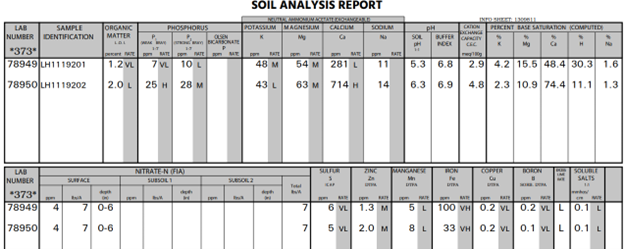When it comes to Agriculture, we are never done learning and progressing. A big shift over the last couple of years is the focus on “proper soil health”. Which is a very broad phrase. There are many aspects that play a role in building and maintaining a healthy soil. From the cation exchange capacity, organic matter, pH, ppm of the main elements as well as the minor nutrients. The best starting point to understanding what your soil needs is to soil test. Specifically, a soil test that will give you a full detailed analysis. This will allow you to get a full understanding of your soil and what will be needed to adjust the ground for ideal conditions.
Soil Testing
In a traditional soil test, you will generally get a pH reading as well as ppm of the main elements Ca, Mg, K, and Na. This is usually followed by a recommendation of which fertilizer you will need.
We recommend taking this a step further and getting a soil report that includes the base saturation of the soil. This is to prevent overspending on fertilizer and calcium by allowing us to get a more detailed look on what is needed in the soil.

This is important because when looking at a sample, the immediate reaction is to look at the pH and ppm of the P and K. Then generally following whatever fertilizer program is recommended. However, the pH only gives you an indication that something could be wrong or off balance in the soil. What we try to look for is why the pH is low or high. This starts with looking into the capacity in which nutrients can be held in the soil (this is shown by the Cation Exchange Capacity (C.E.C.) of the soil.) as well as the base saturation and its correlation to the pH.
Base saturation
Let’s start with the Cation Exchange Capacity (C.E.C.) ability to hold and supply nutrients such as calcium, magnesium, potassium, nitrogen, water, and other trace elements and micronutrients. Think of C.E.C. as a cup and the higher the number, the bigger the cup. Sandy soils naturally have a lower C.E.C. and in turn cannot hold as many nutrients as a higher C.E.C. soil. Once we understand what type of soil we are dealing with, we can start to look at the base saturation of the soil. Base saturation is the nutrients that are filling up that “cup” such as calcium, magnesium, potassium, hydrogen, and sodium. Of these the most important nutrient is calcium. It will also take up the most space when the soil is balanced properly. There is an ideal range for each of these nutrients as follows:
Ca: 65-80%
Mg: 15-20%
K: 2-6%
H:10%
Other: <2%
Calcium in the soil
As shown, you want to have a much higher saturation of calcium in the soil than the other nutrients. The roles calcium plays in the soil and in the plant are many; one of the most important roles of calcium is that it is the trucker nutrient for all the other nutrients. Without the proper saturation of calcium, hydrogen is allowed to build up in the soil causing acidity and a lower usability of the other nutrients in the soil. This will directly affect your yields and the quality of growth in your fields.
To achieve a proper balanced healthy soil, it will start with understanding what type of soil you are working with and understanding the relation of the nutrients and their balance in the soil itself. Especially making sure that you have a proper Calcium saturation within your soil.
Without calcium in the soil, root growth will stop. Calcium is responsible for root cap formation and strength which directly affects a plant’s root growth and development. Having a proper calcium saturation in the soil will give a plant greater access to the nutrients it needs to grow.
Calcium is also responsible for the cell wall structure and cell division. Research performed by the Sainsbury Laboratory states, “It has been known for many years that calcium determines the rigidity of the cell wall… In addition to cell walls, Ca2+ also stabilizes cell membranes through the interaction with phospholipids. A low calcium content therefore weakens the cell wall…” (Thor, 2019).
Why use liquid calcium
A plant needs calcium and traditionally, farmers have used ag-lime to fulfill this need. The problem with granular is that it takes at least 6 months to breakdown and become available to the plant. During this time, much of the lime is lost and only a little bit of it will make it into the plant.
In contrast, liquid calcium is already in a form that the plant accepts immediately. It bypasses the need to breakdown for long periods of time and allows the plant to access it right away. The product is rain fast in 6 hours and is typically working its way into the soil right away. However, soil always takes some time to absorb new nutrients, so typically a period of about 30 days is needed for soil levels to adjust and pH to become balanced.
Calcium is meant to store in the soil from season to season. Whether introduced through a liquid form or dry lime, calcium is slowly used up by the plant. What this means is liquid calcium typically only needs to be applied every 3+ years. Regardless, it is important to keep up with soil conditions by regularly taking a soil test, and is always the most beneficial way of knowing when liquid calcium needs to be re-applied.
How is liquid calcium applied
AgriTec’s Bio-Active Liquid Calcium comes in a liquid concentrated state. At time of application the liquid calcium must be mixed with water at a standard rate of 5:1 or greater. The liquid calcium can then be applied with a standard ag sprayer, boom sprayers, and single/dual point sprayers work equally well for applying calcium to the soil.


